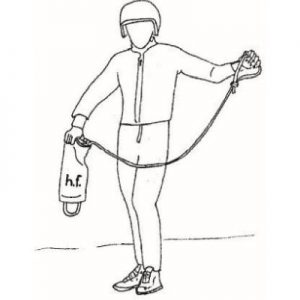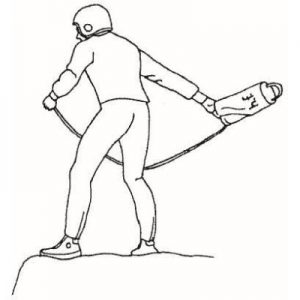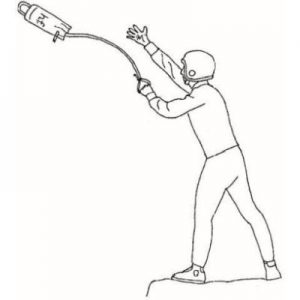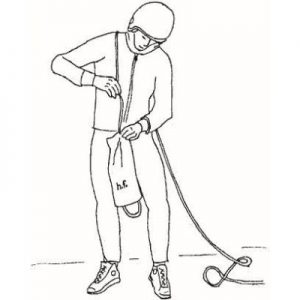
Paddle People
safety in an extreme world
Using the °hf throwbag
A throwbag is the most important piece of safety equipment a paddler can carry. It gives you a way to rescue a swimmer from dangerous currents, whether that is on a whitewater river or a weir on a touring river. Always take it with you when you paddle and make sure it is ready for fast deployment.
Basic throw rescue
Get ready to throw
- Choose the right place to throw your bag. It should be clear of obstacles, not have any hazards downstream and be safe for you to throw from. There should be an eddy downstream to swing the swimmer into.
- Get a good footing, with your fet shoulder-width apart.
- Open the bag.
- Take out about two metres of rope.
- Hold the bag in your throwing hand, and grab the rope with your other hand. Do not fix it to anything.
Throw
- Shout „rope“ to make contact with the swimmer. If they are not expecting your line, they won´t catch it.
- Throw the bag underarm; swing it out behind you, back past your leg, and release it as your hand comes in line with the swimmer.
- Aim to throw the bag past the swimmer so they can catch the line.
- Brace yourself for the strain, and let the current swing the swimmer into the bank.
Repack your bag
Run the line over your shoulder with the bag in front of you. Feed the line into the bag a little at a time, creating a controlled pile inside the bag. Never coil the rope
-

- Get ready
-

- Swing
-

- Throw
-

- Repack
Care instructions
Care and maintenance
AFTER USE: Take the rope out of its bag and rinse it in fresh water, then hang it to dry. Keep it out of direct sunlight as UV-rays and direct heat will damage it. Repack your throwbag carefully before storing it. If it´s been in storage for more than three months, repack it again before you paddle.
Never stand on your rope.
Don´t run it over hard sharp edges.
Don´t run it over trees or poles – the friction will damage it.
Inspect your throwbag regularly. Check the knot, bag and rope for tears, cuts, melted rope surface, loose strands etc.
The knots should have 7-10 cm of loose rope from them. If the rope is damaged, it´s not safe to use. You need to make sure that no-one can use it _ even by accident. So cut it into short lengths and bin it.
If you find your equipment is fault discard it, get it repaired or replace it immediately.
Replace your throwbag after six years or 250 days of use at the latest, even if it doesn´t look worn.
Only use the throwbag for the rescue situation described above. Do not misuse! Any use other than the purpose for which it was designed for will impact your safety.
Training
Inspect your throwbag before you use it. Then take it down the riverbank and practice throwing it into the water. It´s a good idea to practice on a moving target, like a piece of driftwood.
When your line is new, production residue will make it slippery. Once you have used it a few times, the rope will get more grip. Just carrying a throwbag won´t make you safer if you do not know how to use it. Practice regularly – you need to be able to hit your target first time.
Clean Rope Principle
Some paddlers choose to remove the handle at the rescuers end of the line. This keeps the rope „clean“ of knots, which can reduce the risk of entrapment hazards.
There are pros and cons to using a handle or using a clean line. Choose for yourself and – if you choose to – untie the knot to get rid of the handle.
Knife
Always carry a knife when you carry a rope.
Safety Advise
In addition to the standard situation described above a throwbag offers the trained and experienced user multiple rescue options. Descriptions of these techniques can be found in specialist publications. Further than training is available from canoe clubs and organizations. Advanced rescue options require training and knowledge that cannot be provided by this user manual. Unless you have had special training, are aware of the potential risks and know how to avoid them you should only ever attempt the basic throw rescue.
© 2020 Paddle People GmbH